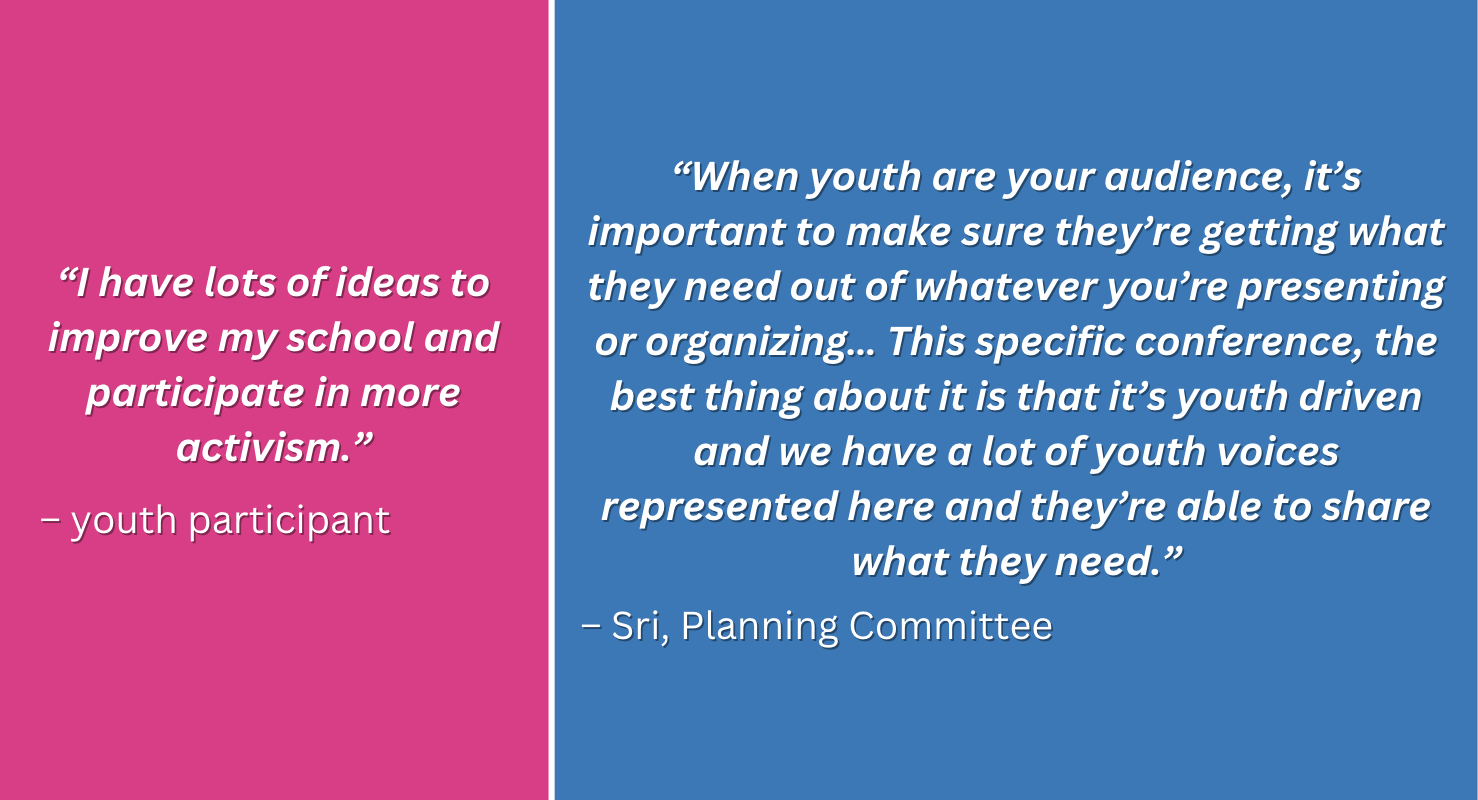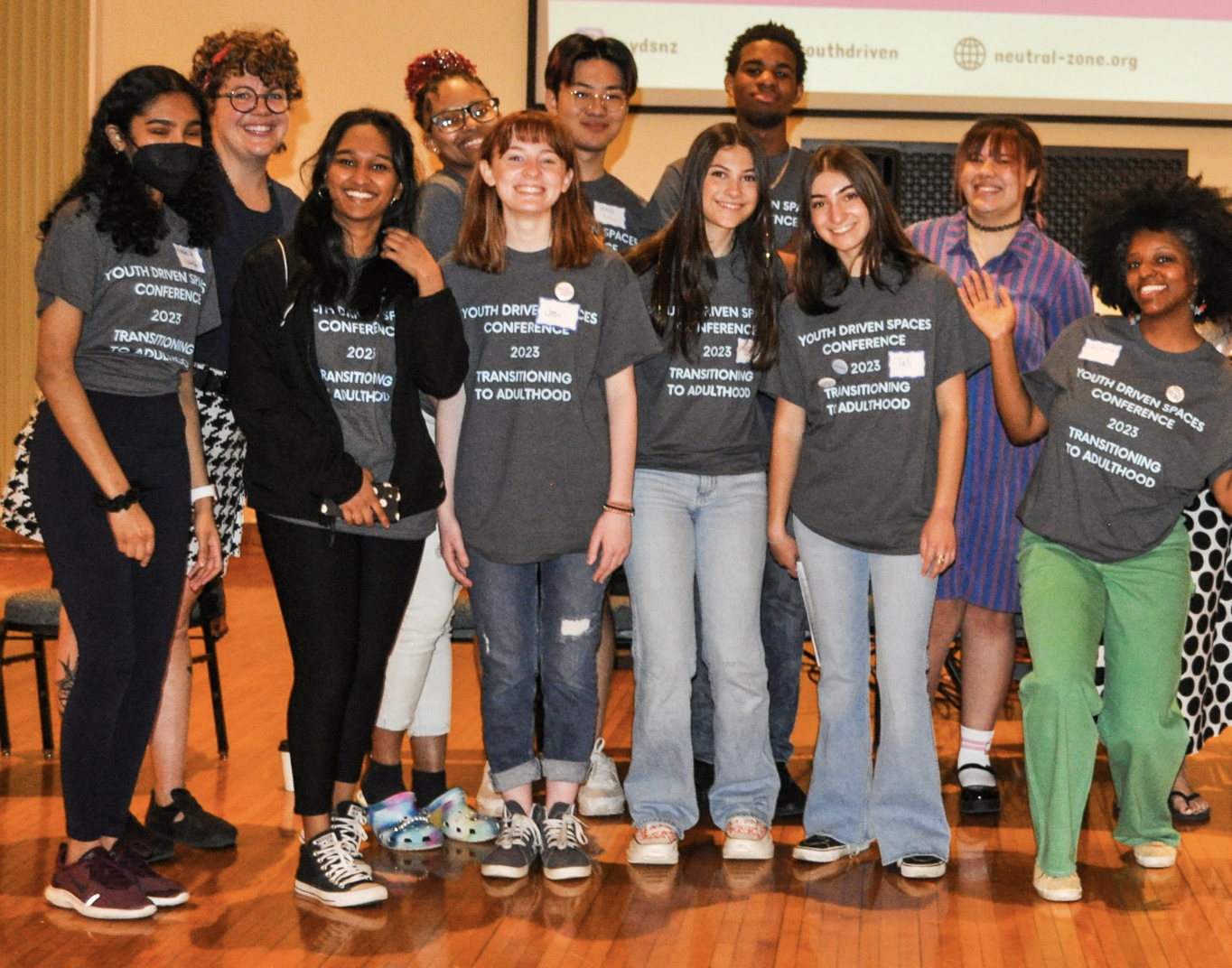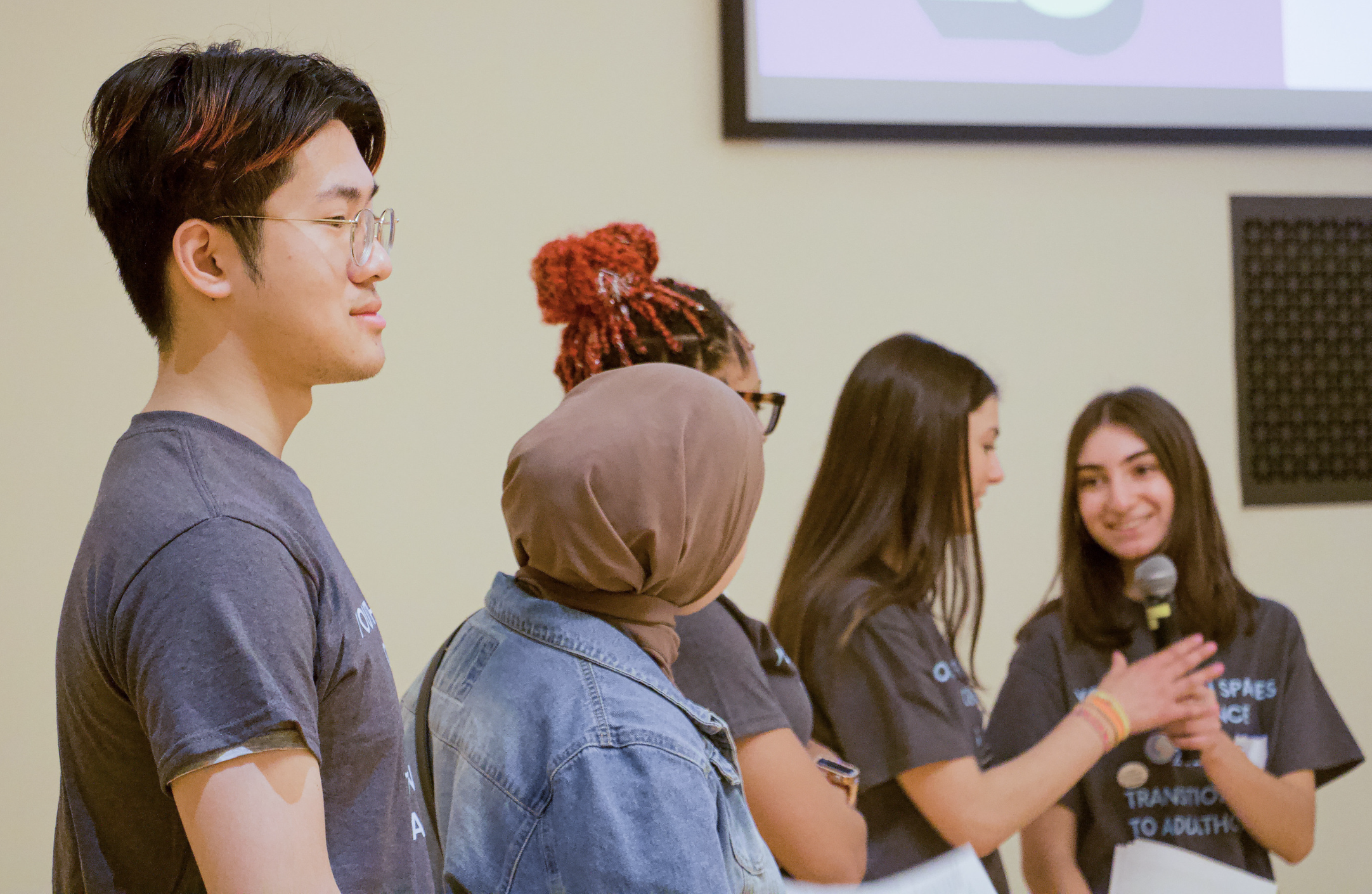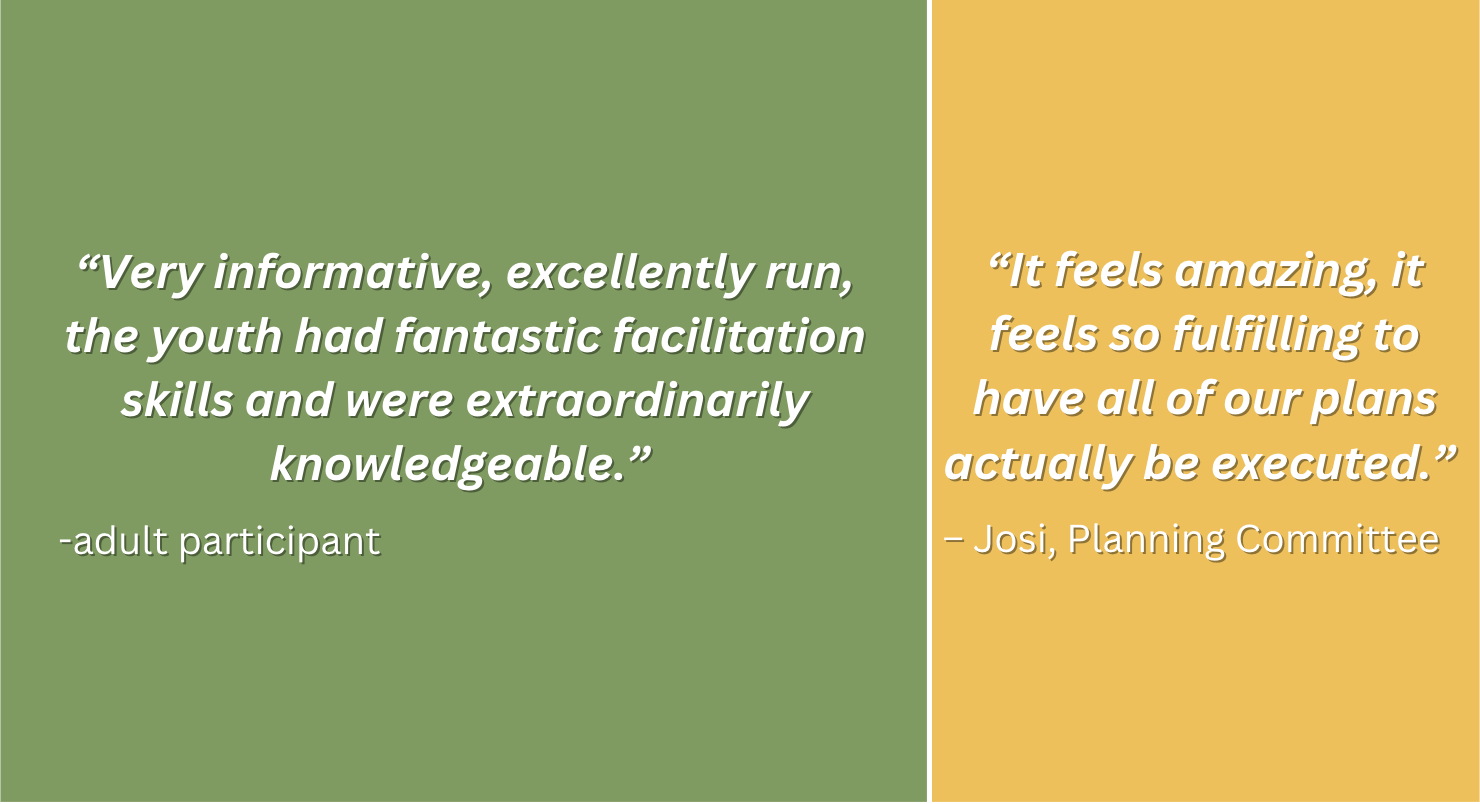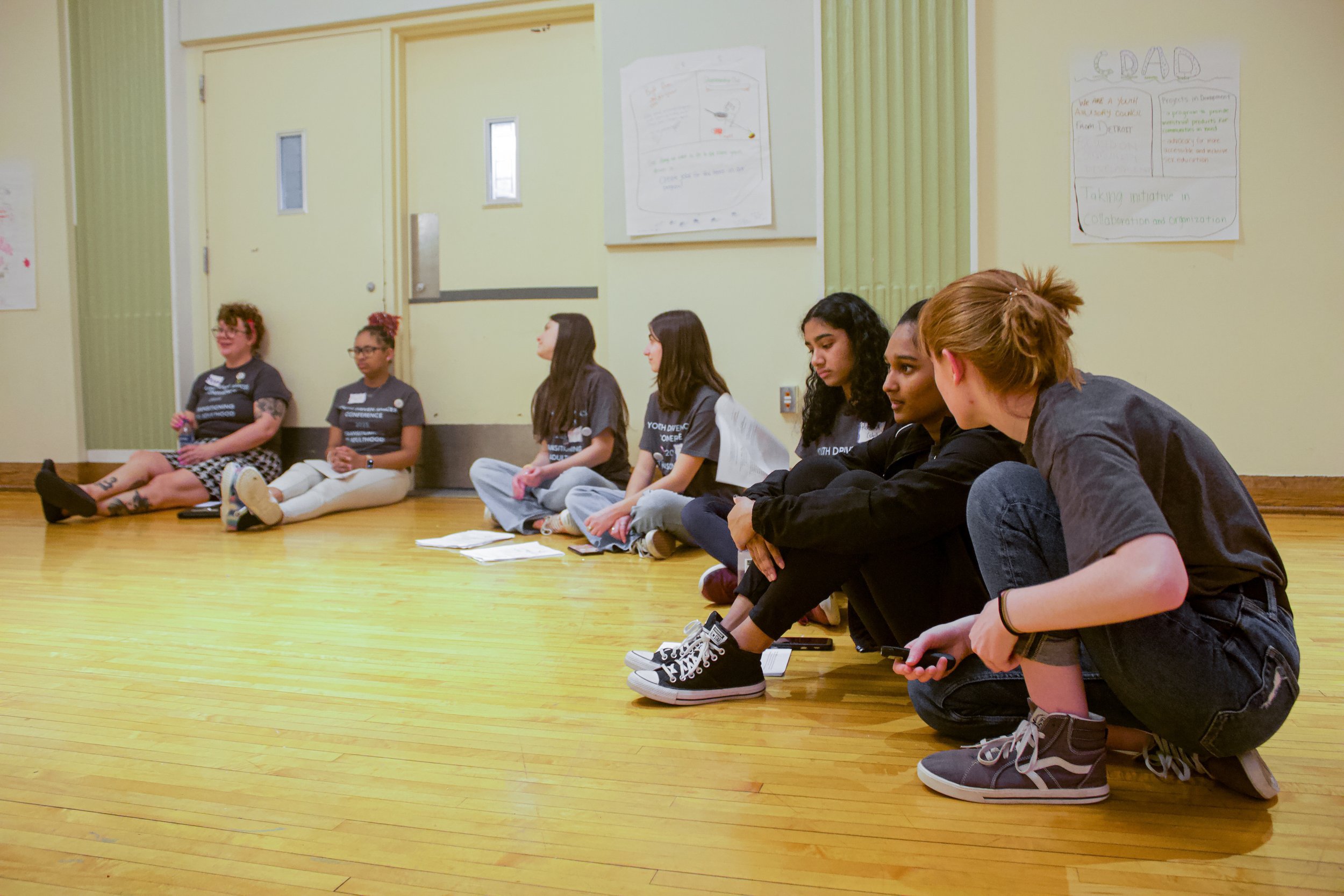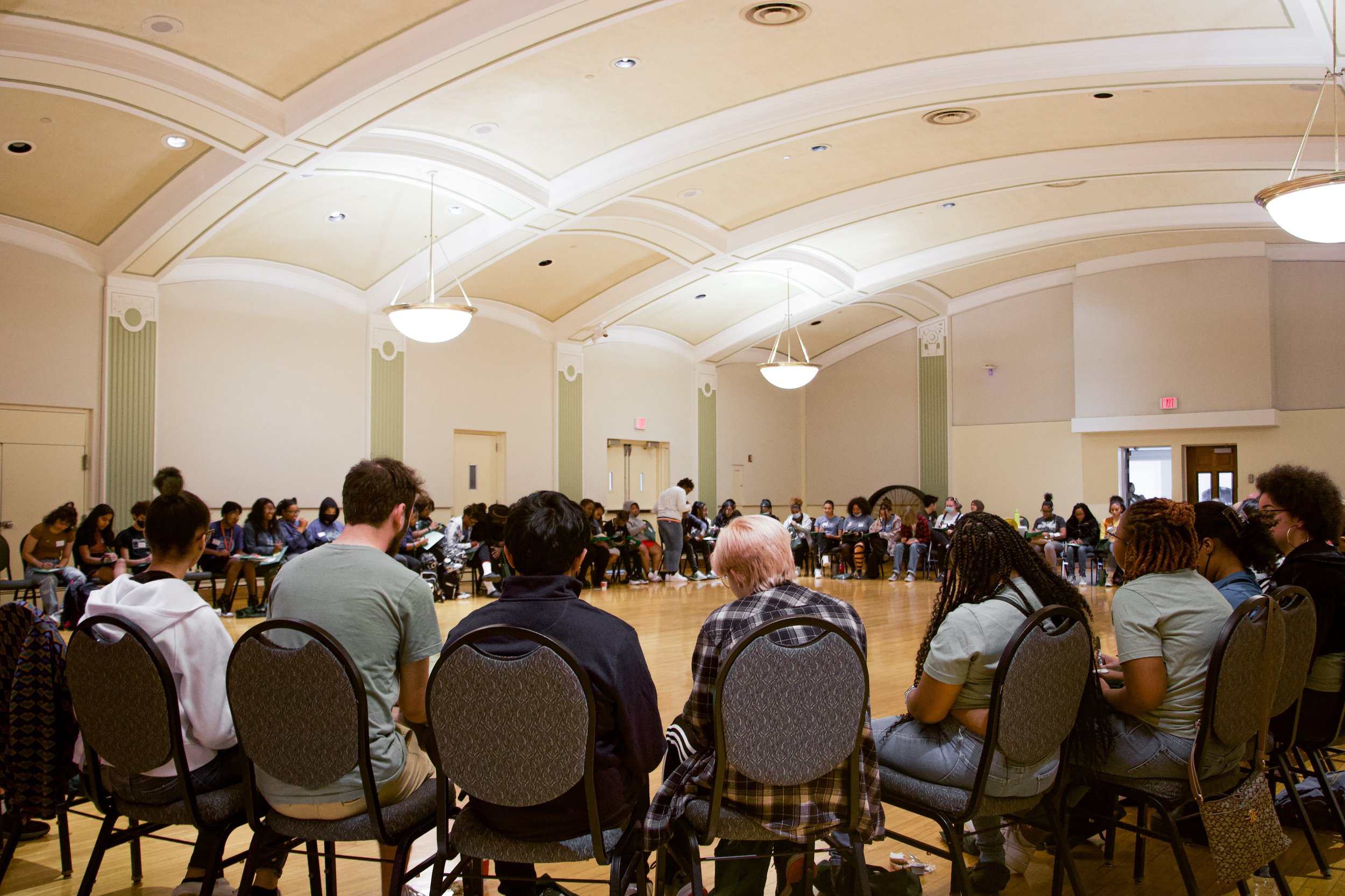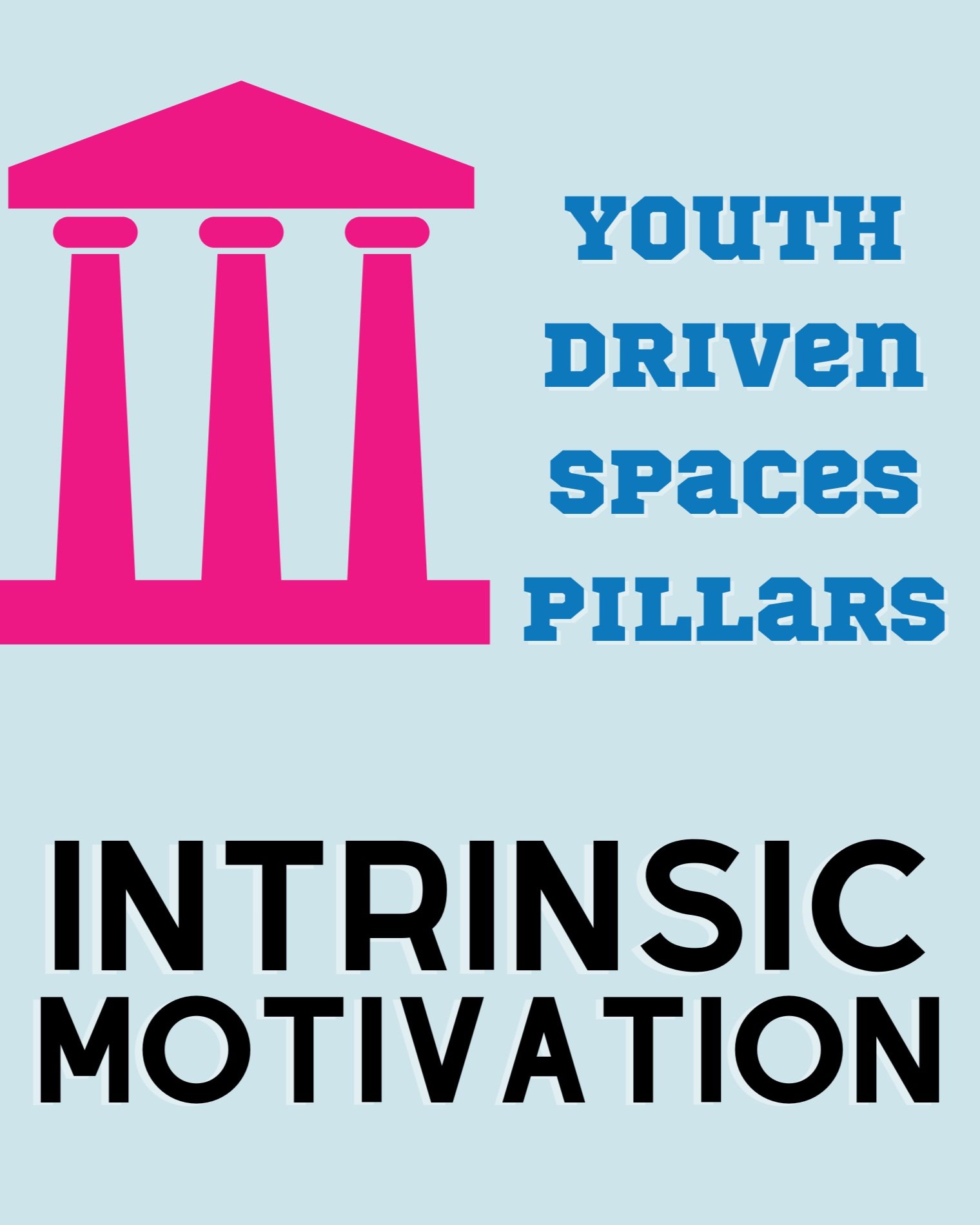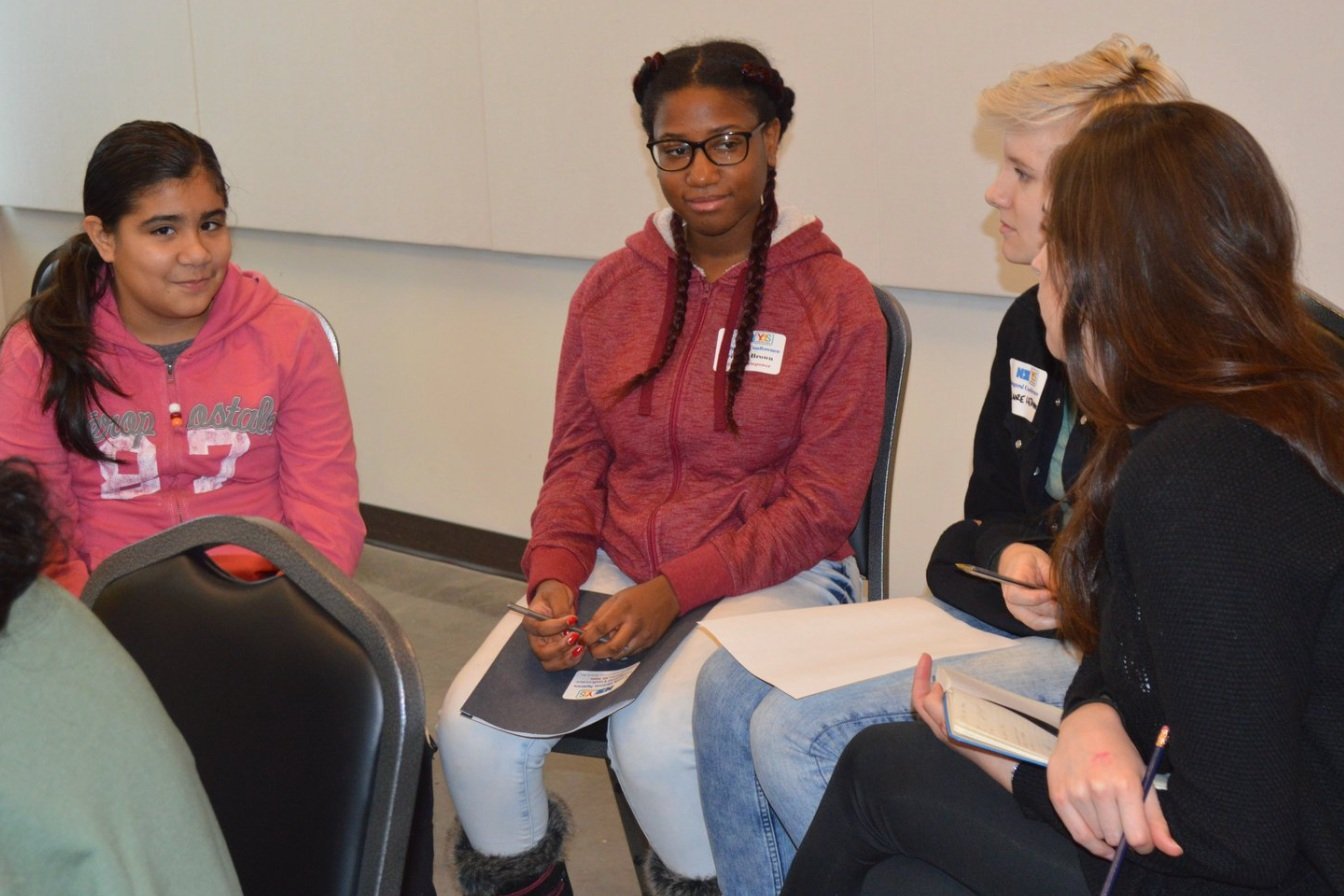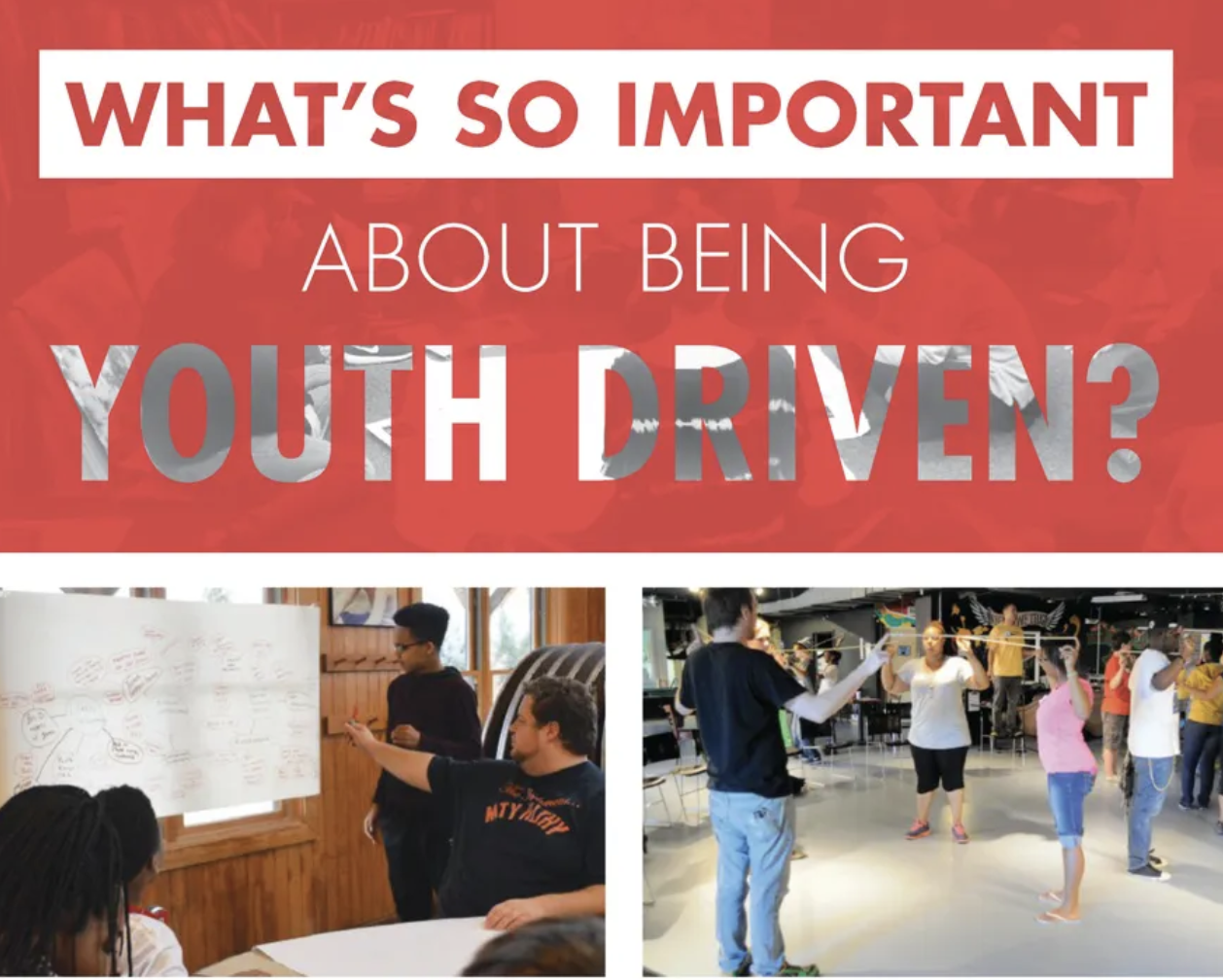
Teen Led Events
2023 | May
Teen Led Events
YDSC '23: Youth Led Planning in Practice
〰️
YDSC '23: Youth Led Planning in Practice 〰️
By Bubbles DuMouchel
-
On April fifteenth, the air in EMU’s McKenny Hall was already cooking at the ripe hour of 9 a.m.. The electric buzz of noise and energy practically summoned you to the registration tables of the 2023 Annual Youth Driven Space Conference. With stereotypes of teenagers being lazy and grouchy all hours of every day, you might have expected a different scene but this was reality check one of the day; the teen conference members were more alive than anyone.
The concept of the Youth Driven Spaces Conference is simple: a day-long event with workshops and networking for teens in Southeast Michigan created by those who know them best; their peers. For the past five months, a dedicated teen committee of 10 had taken the ‘nebulous’ idea of a conference and crafted it into what we were about to experience. With two adult allies on standby, they flourished to cover all the essentials from sending registration and reminder emails, to picking organizations to present workshops, to designing swag. There wasn’t an aspect of this conference missing teen input.
Teens and adult allies from all over southeast Michigan were bringing the same energy the committee members were bringing. As the day kicked off, the committee ran us through community building activities they picked, group norms they agreed on, and a schedule they planned. Following lunch, youth representing five organizations led workshops on the theme of Transitioning to Adulthood. People were making fans out of nearby paper but ninety degrees couldn’t cook the enthusiasm out of the conference.
In the end nearly 100 youth and adults representing 20 organizations in Southeast Michigan participated in the conference.
Two planning committee members weighed in on what the experience of planning this conference was like for them.
“When youth are your audience, it’s important to make sure they’re getting what they need out of whatever you’re presenting or organizing… This specific conference, the best thing about it is that it’s youth driven and we have a lot of youth voices represented here and they’re able to share what they need.”
– Sri, Workshops & Pitches Committee
“It feels amazing, it feels so fulfilling to have all of our plans actually be executed.”
– Josi, Communications Committee
-
We received anonymous appreciations throughout the conference saying things like I appreciate “space and opportunity to connect with my org”, “meeting the most amazing people ever ッ♡”, “very welcoming hosts and balanced information”, and “talking & networking with new people ♥”.
Workshop Participants
Youth Perspectives
“I learned things that I wouldn’t have learned otherwise and I wouldn’t have been curious enough to search on my own.”
“I have lots of ideas to improve my school and participate in more activism.”
“I learned how to facilitate a workshop!”
“I loved the talks we had, they were open and honest and taught me new terms.”
“I learned a lot about managing money and safe sex. Ultimately, I feel more prepared for adulthood.”
“It got me fired up to bring awareness and fight for my rights even in school!”
Adult Perspectives
“This workshop was super impactful. I took away the ways in which we can include all voices in our activism and make sure that our local work has larger impacts.”
“Very informative, excellently run, the youth had fantastic facilitation skills and were extraordinarily knowledgeable.”
“We had a really great group discussion and I was empowered by the ways youth are able to discuss mental health.”
Event Planning Resources
Planning any event can be overwhelming, there are so many details to manage. While there is often energy for the concept of the event, the finer details are easily overlooked -- who are you hoping to reach, what organizational values does the event express, who will create the flier and by when?
As a resource, we are sharing two tools. A big picture planning template to help your group grapple with the more conceptual aspects of event planning, such as the goals, potential partners, and event logistics. As well as a generic checklist based on many of the tasks we completed in the YDS Conference planning process. We encourage you to download or make a copy of the documents so it can be useful to you.
Youth Adult Partnership
2023 | March
Youth Adult Partnership
What Does Youth Adult Partnership Actually Look Like?
By John Weiss and Tom Akiva
An excerpt from The Heartbeat of the Youth Development Field: Professional Journeys of Growth, Connection, and Transformation (2023)
-
The term Youth Adult Partnerships (YAP) has an intuitive meaning for many people in the youth field; however, nearly two decades of research and scholarship (Zeldin et al., 2013; Kirscher 2015) provide a deeper and intentional understanding of the term and its most important components. As defined by Zeldin and colleagues (2013), youth adult partnerships is the practice of: (a) multiple youth and multiple adults deliberating and acting together, (b) in a collective [democratic] fashion (c) over a sustained period of time, (d) through shared work, (e) intended to promote social justice, strengthen an organization and/or affirmatively address a community issue.
To break this definition down deeper, consider the following ideas. Multiple youth and multiple adults acting together can provide a more co-equal, democratic and reciprocal group dynamic that is different from the typical youth-adult interactions found in traditional youth programs. In those programs normally a lone adult guides or facilitates the youth members, as its mentor; there is little or no emphasis on development of a co-equal intergenerational group. Furthermore, strong YAPs work democratically across the group over a sustained period of time, not simply on a short term project. The purpose of the work is for some meaningful community or organizational based change, as opposed to say a simple skills development based project.
Furthermore this scholarship identifies four components which drive successful YAPs: authentic decision making, natural mentors, reciprocal activity, and community connectedness (Zeldin et al., 2013). Authentic decision making, tied directly to the developmental need of meaningful participation, has been found to lead to the development of agency as well as confidence to achieve one’s personal goals, both important facets of engagement. Natural mentorship is the concept of letting youth naturally choose the adults they feel most connected to and to (informally or formally) rely on them as mentors. This turns the traditional approach to mentorship programs upside down where adults are assigned to youth. Furthermore the effectiveness of natural mentorships relies on their being multiple adults, hopefully with varying identities and interests, for youth to seek out and naturally connect with. Reciprocity is the idea that youth can contribute and co-create alongside adults, especially by recognizing and revering their unique perspectives and experiences which are often very different than the adults. Their contributions are especially important in YAPs in which the group is working to strengthen an organization with a youth service mission. Finally, community connectedness is the idea of linking the work of the YAP to the larger community. This has several benefits including providing access for youth to people, organizations and networks that expand their social capital. Furthermore youth feelings of connectedness with adults and public institutions are shown to be strong predictors of future civic engagement. And lastly, community connectedness helps to transform the large communities perceptions of youth from the negative stereotypes to those of competent, engaged citizens.
-
A brief story below elucidates a successful YAP from Neutral Zone. The story takes place in the context of the Youth Driven Spaces (YDS) initiative, which involves young people as teen interns and trainers who work closely with staff to plan and implement the capacity building work Neutral Zone supports with other community-based organizations.
In 2018, Sanvi, a high school junior,was chosen to serve as an intern for YDS. Sanvi enthusiastically jumped into her internship, working alongside the 3 adult staff who led the YDS training and coaching activities and also with 11 peers--teen leaders and emerging leaders who met monthly to be trained as trainers. One of Sanvi’s first tasks was helping to select six partner organizations that would receive training and coaching through a grant funded project. She read through the applications, scored a readiness rubric for each organization, and helped conduct phone interviews with several of the applying organizations. Sanvi was an integral and important part of the selection team, offering insights and ideas that were unique to her experience as a teen participant at a youth-driven organization. Her contributions helped us reconsider and invite one organization that the adult staff wasn’t sure was ready and also affirmed a barrier for another organization that we asked to wait a year before joining as a partner. Sanvi continued to deepen her involvement as a lead teen trainer, working closely with Karen and Naja (two of the NZ staff) and on evaluative aspects of the project with John (Weiss).
This story illustrates effective youth-adult partnerships. Sanvi served with a group of multiple youth and adults, working democratically, over a sustained period of time to help strengthen the work of Neutral Zone and that of its community partners. Through her involvement across various aspects of the project, she made authentic decisions and participated in reciprocity, contributing via her unique positionality as a teen to help select partner organizations and subsequently be a supportive trainer to peers from other organizations. Sanvi sought out natural mentorships, learning from each of the adult staff and connecting with them over their identities or areas of expertise. Finally Sanvi’s work provided her wide access to a range of other organizations, especially peers from outside the city, with whom she maintained relationships beyond the project.
-
Starr, Elizabeth, et al. The Heartbeat of the Youth Development Field: Professional Journeys of Growth, Connection, and Transformation. United States, Information Age Publishing, Incorporated, 2022. p68-72
Tools | Youth Adult Partnership
The Ladder of Student Involvement
The Ladder of Student Involvement was developed by Adam Fletcher (2011) to "encourage students and adults to examine why and how students participate throughout schools". The ladder can be used as a reflection and planning tool in schools and community organizations.
Youth adult partnership is the highest rung on the ladder (described as student/adult equity), demonstrating it is a youth engagement approach that many strive for and that, according to Fletcher, "requires conscious commitment by all participants to overcome all barriers".
A rubric describing each rung and it's associated challenges and rewards, can be found here.
Evaluating Youth Adult Partnerships
The Youth-Adult Partnership Rubric is a tool for professional development and program evaluation in youth settings. It was developed by Michigan State University and Neutral Zone. The Rubric evaluates four critical dimensions of Youth Adult Partnership: (1) authentic decision-making, (2) natural mentors, (3) reciprocity, and (4) community connectedness.
Your Turn!
Identify a program or settings that involves multiple high school aged youth and adult(s) working together toward a common goal and have someone observe, take notes, and complete the Rubric.
Intrinsic Motivation
2023 | February
What's So Important About Intrinsic Motivation?
By John Weiss
-
Have your band play a concert in a 400 person venue. Design and silkscreen your own shirts. Learn how to make beats in a genuine music studio. Plan and throw a huge art show for the community.
These are just some of the compelling opportunities that take place at the Neutral Zone and which draw some 400-500 teens to come to the center regularly each year.
Compare these activities to what normally happens for students in school (take a biology test, write a paper analyzing population and settlement patterns, read the chapter on Euclidean geometry and fill out the worksheet) and it's no wonder that most youth prefer out of school time programs over school.
So why do after-school arts and leadership programs like the Neutral Zone hook students in and keep them coming back? One of the key factors is intrinsic motivation. Intrinsic motivation refers to behavior that is driven by internal rewards, behavior which arises from within an individual because it is pleasing and personally rewarding. This contrasts with extrinsic motivation, which involves engaging in a behavior in order to earn external rewards (good grades, money, recognition) or avoid punishments.
Intrinsically motivated behaviors carry their own rewards. These rewards involve creating positive emotions within an individual which can include a sense of meaning, a sense of progress or feelings of competence and achievement.
Researchers have discovered that offering external rewards or reinforcements for an already internally rewarding activity can actually make the activity less intrinsically rewarding, a phenomenon known as the overjustification effect.
Research also suggests that people are more creative when they are intrinsically motivated. In work or school settings, productivity may be increased by using extrinsic rewards such as bonuses or good grades, but the actual quality of the work performed is influenced by intrinsic factors. If you are doing something that you find rewarding, interesting, and challenging, you are more likely to come up with novel ideas and creative solutions.
-
Intrinsic motivation is an important driver in education and after-school programs. Malone and Lepper (1987) identify several different ways to create environments that are intrinsically rewarding. The factors that they identify as increasing intrinsic motivation are:
Enjoyment: We are motivated by the things we enjoy, find pleasing and like doing. Think of the drudgery many people have when they need to clean their home. Contrast that with going out to a concert of your favorite artist or checking out a new movie that you’ve been excited to see. In after-school programs when we offer program choices that students’ enjoy (beat making, silk screening, dance) we are helping to motivate them and to pursue high levels of engagement.
Curiosity: Internal motivation is increased when something in the environment grabs our attention (sensory curiosity) and when something about the activity stimulates the person to want to learn more (cognitive curiosity). Think about those places that peak your curiosity - a craft store with lots of interesting supplies, a new city with lots of alluring restaurants. Providing a program space that includes a variety of ways and things to tap youths’ curiosity helps to draw them in and makes them want to engage.
Challenge: People are more motivated when they pursue goals with personal meaning and when attaining the goal is possible but not necessarily certain. Take for instance learning to play one of your favorite songs on an instrument. If the song is slightly above your current playing level (and you really love it!) you will be intrinsically motivated to keep practicing it until you master it. Being challenged helps us work at a continuously optimal level toward meaningful goals.
Control: People want control over themselves and their environments, to have a sense of control over our the activities in our daily lives. This is true for adults and true for youth. By offering youth choice in what they pursue, how they go about it and even whether to engage or not - we are providing them control over their situations and as a result help keep them motivated intrinsically.
Too many of our spaces for young people (especially schools) have an over-reliance on external rewards, behavior charts, and punishments all meant to keep youth on track. We need to counterbalance these approaches with ones that focus on developing self determined people, environments that fill students with a sense of competence, autonomy, and satisfaction. By focusing on how to best support youths’ intrinsic motivation we can go a long way in supporting that goal.
-
Malone, T. W. & Lepper, M. R. (1987). Making learning fun: A taxonomy of intrinsic motivations for learning. In R. E. Snow & M. J. Farr (Eds.), Aptitude, learning, and instruction: III. Conative and affective process analysis. Hillsdale, NJ: Erlbaum.
-
When I first began participating in programming at Neutral Zone, it was a few months into lockdown during the COVID-19 pandemic. I was stuck at home with nothing to do but go to virtual school and virtual dance classes. Both were unfulfilling and began to feel like nothing but a chore within a few weeks. I was desperate for something fun to fill my time, and then I remembered the Neutral Zone. I had been to a few events there but didn’t know much about the organization. After looking through the programs offered, Riot Youth, an LGBTQ+ activism and social support group, was the one that stuck out to me. I registered for the program and attended my first meeting (virtually) later that week. Neutral Zone quickly became a second home to me, and I’ve been attending programs, events, and meetings regularly ever since.
My time at Neutral Zone has been everything I wanted it to be and so much more. I had the opportunity to be in a safe space with other queer people, expand upon my leadership skills, and make positive change within my community. This allowed me to fulfill my desire to have something fun and worthwhile to do with my time, and it is because of this intrinsic motivation to attend programming that I can fully enjoy the work I do there. If I was simply working for an external reward, things such as going to board meetings would just feel like a task, but I am there simply because I want to be, and I look forward to going to Neutral Zone every time.
-
I first attended one of Neutral Zone’s events in 8th grade. It was an event to bring in new teens, and my parents insisted I attend. After the event, I didn’t plan on having too much involvement… until the Covid-19 lockdown. All I had to do was play video games, take online percussion lessons, and be on my phone. My friend Stevie posted something on their social media about a Neutral Zone program called Riot Youth. I decided it seemed cool, at least based on the flier, and I had nothing better to do, so I went. It was super fun; everyone was friendly, so I kept going. A little while after, Stevie and I both became the Youth Facilitators. After that, we received an invitation to be on the Board of Directors, which we both accepted. I started attending regular board meetings, became a teen intern during the summer programs, and, more recently, the Co-President of the Board of Directors and the Youth Facilitator of Picture This!, Neutral Zone’s photography program.
I found a second home at the Neutral Zone, where I can be myself, learn and grow, and be part of a growing community. The intrinsic motivation to be around others that I can connect with allows me to properly serve as the Co-President of the Board and the youth facilitator of Picture This!. I’ve had many opportunities I may not have otherwise, and I am forever grateful.
Intrinsic Motivation Exercise
Intrinsic motivation, the motivation from within, is driven by several different components including: enjoyment, curiosity, challenge and control.
As a way to reflect on IM, you (or you and some colleagues) can brainstorm the ways you could uplift IM in your programs across these four domains. Using the table below first reflect on:
How can we increase youth enjoyment in our programs and activities?
How can we tap young peoples’ curiosity through our program activities?
What are ways to provide ‘challenges’ for young people - helping them to stretch out of their comfort zone (but not too far as to make it unreachable)?
How can we provide more control to youth in their program offerings and activities?
Once you’ve brainstormed a number of ideas - put a star next to a couple you can implement right away and circle a couple you want to work on, over time.
Why Build Community
2023 | January
Why Build Community
〰️
Why Build Community 〰️
Why Build Community
By John Weiss
-
At Neutral Zone we believe that teens should feel welcome, that they make a connection to others, and that they feel valued. Researchers argue that sense of belonging is a fundamental human need (Baumeister & Learny, 1995; Deci and Ryan, 2000; Maslow, 1943). The National Research Council (Eccles & Gootman, 2002) lists “opportunities to belong” as one of the most important features of a high quality youth setting. Youth benefit tremendously from an intentional focus on mattering and belonging which helps them to develop social and emotional competencies, decrease negative behavior, take greater learning risks, and develop ownership of their environment and learning.
One of the important ways we foster mattering and belonging at the Neutral Zone is through active, purposeful, collaborative engagement which often first happens in the form of community building activities. We spend intentional time daily, whether in programs or large gatherings, engaging in activities that help us learn/review each other’s names, get to know teen interests and ideas, team-build, or activate our brains and bodies through energizers. Much of this active time is spent in circles, a strategy that is both an
important component of restorative practice and has a long and rich history, extending back to indigenous cultures from all over the world. Meeting in a circle encourages meaningful dialogues, is a symbol of equity and connection and provides no back row for teens to hide or check out. Responsibility is shared, and everyone is encouraged to participate and contribute.
Building community is an essential way to establish a positive emotional climate in a school or youth setting. Establishing such a climate is key to supporting youth motivation, engagement, interest, and learning.
-
For those who think of community building as silly “icebreakers” that essentially all have the same purpose, we disagree. Community building is intentional and purposeful with many aspects that are necessary to consider and plan for in order to do them effectively. Here are some things to keep in mind:
:: Safety and Comfort :: In order for community building activities to be most effective, the safety and comfort of participants and facilitators must come first. This means working to create an environment that actively supports the emotional and physical well-being of all participants which includes the size of the spaces in use, the location, and being aware of any objects that may pose a hazard especially when working with a group of varied ability status. For emotional well-being, remember to check in periodically both on a group and individual level and keep an eye on participants’ body language, to gauge their comfort levels.
:: Group Development :: Groups tend to move through several stages before they become cohesive and can work well together. Consider “risk level” in relation to the stage of the group’s development when choosing an activity. Many elements impact risk level (high, medium and low) including whether there is close physical contact or how deeply you may be asking participants to share.
:: Language Use :: Deliberate language usage is vital to ensure that each participant feels they matter and belong. For example, note the difference between the phrases “have to” and “get to”. The phrase, “have to” conveys a lack of options and emphasizes a power imbalance between facilitator and participant; the phrase “get to” enhances a fun environment and also allows participants to refuse if they so desire. Another way to promote purposeful language use is by setting up community norms at the beginning of each session.
:: Promotion of Diversity and Inclusion :: While building community, keep in mind that groups are made up of individuals, with a wide variety of backgrounds, social identities, abilities and experiences. Acknowledging and appreciating diversity is more appropriate than ignoring identity or pretending that factors that create and/or contribute to identity (i.e. race, ethnicity, socioeconomic status, gender, religion, sexual orientation, ability, age) do not exist. Other strategies for promoting respect for diversity include making an effort to meet new people, listening with an open heart, educating yourself to confront internalized biases, and actively speaking out against discrimination. Additionally, it’s critical to promote inclusion by making space for everyone in activities and conversation, being mindful of ability status (physical and mental) and allowing people a variety of ways to participate. Model a norm of inclusivity by encouraging participants to remember names, strike up conversations, and check up on their fellow members. Taking one person aside to check-in if they seem uncomfortable, or making an effort to connect with participants is important work towards this goal, as well as boldly naming inclusion as a goal.
-
Baumeister, R. F., & Leary, M. R. (1995). The need to belong: Desire for interpersonal attachments as a fundamental human motivation. Psychological Bulletin, 117(3), 497–529.
Eccles, J., & Gootman, J. A. (Eds.) (2002). Community programs to promote youth development. Committee on community-level pro- grams for youth. Washington: National Academy Press.
Maslow, A. H. (1943). A theory of human motivation. Psychological Review, 50(4), 370–396
Ryan, R. M., & Deci, E. L. (2000). Self-determination theory and the facilitation of intrinsic motivation, social development, and well-being. American Psychologist, 55, 68-78.
A CASE FOR INTEGRATING COMMUNITY BUILDING
〰️
A CASE FOR INTEGRATING COMMUNITY BUILDING 〰️
A Case For Integrating Community Building
By Megan Mueller Johnson
(Note: J is a pseudonym for a Neutral Zone participant.)
This past September, in alignment with the new school year, the Neutral Zone began our after school Drop-in Program. During the first few weeks of Drop-in, I regularly heard teens new to the space say they specifically came to be with people their age in person and to make friends. Teens continually referenced isolating and schooling from home during the beginning of the Covid-19 pandemic as the inspiration and motivation to show up and try to make friends.
I sat down with J, a senior in high school, to discuss their experience meeting and connecting to people at Neutral Zone. For J, being in a semi-structured space with peers is the draw, however, staff knowing their name and talking to them provides enough support to take risks and connect with new people. J’s experience highlights the importance of intentionally incorporating community building within programming and continually reflecting on the social-emotional needs of program participants at this moment in history.
-
It’s a good place to relax… I don’t know a lot of people and that’s partially because I don’t talk to a lot of people but I want to. I want more friends and I want to know more people that I wouldn’t just be talking to online. Because the vast majority of my friends in Michigan are basically all online friends at this point.
-
My base instinct is that it’s a place that I go to. But it’s more than that… it's a very open place and there isn’t this structure of things where this is the allotted time for this structured activity that you may or may not be interested in. I’m just hanging out.
-
I wish I was more connected to others at Neutral Zone. I want to talk to more people but I don’t know how to start conversations and it sometimes annoys people to join them mid-conversation… I think a lot of people are here for the same reason as me, which is a place to chill for a while. Whether it’s [because] you don’t want to go home or you have something later and you need a place to go before that.
-
They talk to me! Adults who part of their job is talking to kids, talk to kids a lot more than kids do. Or at the very least talk to me more than kids do. I think the first few times I went to Neutral Zone I was like “this isn’t very fun” and now a lot of the staff know my name so that feels a lot nicer. I think if the staff didn’t interact with the kids I probably wouldn’t come back often because I don’t talk to people my age enough and I tend to connect a lot more with adults.
Community Building Activities
〰️
Community Building Activities 〰️
Community Building Activities
-
Materials: List of statements (see page 73 in the Community Building Guidebook to get started)
Time: 10-20 minutes
Purpose: This activity provides an opportunity to assess the group before or after an activity. It can also be used as a simple ice breaker, or as a way to explore power dynamics and ideas of diversity.
Procedure:
Ask all participants to stand on one side of the room. Tell them you will read a series of statements.
Once you read a statement, everyone for whom that statement is personally true walks to the other side of the line. Remind participants that there are no wrong answers. Both sides are to look each other in the eyes. After the first statement, you may wish to use a reflective prompt such as, “Notice who is on one side of the room and notice who is not.” Participants silently acknowledge the configuration of the room’s participants. At this point, you may want to have students speak about their opinion on the matter. Be sure to have individuals from both sides of the line share.
When students are done, ask them to cross back over the line and rejoin the individuals who did not move. Repeat with each statement.
Debrief in a large group.
Adaptations: Also known as “Stand Up If” which asks students to stand up instead of crossing a line. Another adaption is asking participants to stand in a large circle and “Step In if,” before moving back into place for the next statement.
Debrief: Ask participants how it felt to be in the majority/minority. Ask them if that influenced where they stood. Talk about how it felt to have to move to take a stand. How did you feel when you got to choose your answer (e.g. lowering the voting age as opposed to when you had no say in the answer (e.g. being an only child)
-
Materials: None
Time: 10-15 minutes
Purpose: Encourages participants to be silly and loosen up.
Procedure:
Explain to participants the different stages of the evolution, and remind them how to play Rock, Paper, Scissors, if necessary. It is helpful to standardize the rules, for clarity later. For example, decide if people should throw on ‘shoot’, or after.
Players can only play others at the same level of evolution as they are. If they win, they move up the ladder to the next stage, if they lose, they devolve. The lowest stage is the Egg. Players should waddle around, and make themselves short and egg-like.
After winning a round, players become chickens. Chickens flap their wings and make loud squawking noises. The next stage is dinosaurs, who make small claw-like arms, and roar. After dinosaur comes the final stage of the game, superheroes. Superheroes pose like, well... superheroes.
When students beat another superhero, they have won, and they can sit out.
Adaptations: Alternatively, have a Rock, Paper, Scissors Tournament, in which participants compete to be the last one standing by winning a ‘best 2 out of 3’ hand against everyone else. What makes this fun is the idea of cheerleaders: once a participant loses, they must follow the person who beat them, and chant their name or cheer. Cheerleaders should refrain from booing.
Debrief: Refer to page 9 to utilize the Experiential Learning Cycle in order to create a debrief that fits your program’s needs.
-
Materials: None
Time: 5-10 minutes
Purpose: To use memory and motion to learn the names of group members.
Procedure:
Ask everyone to stand in a circle. Demonstrate how the game works by saying your name and performing a sound and motion to accompany it.
Have everyone repeat your name and do your sound and motion. Now ask everyone to think about a motion to go with their name.
Beginning with the person to your left or right, ask them to say their name and complete a sound and motion, after which, everyone repeats that name, sound, and motion
This continues around the circle, so that everyone has an opportunity to introduce themselves.
Adaptations: Participants can also connect their motion with a hobby or pastime. For example, someone might pantomime throwing a ball to represent the fact that they play football. Or, after the last person says their name and motion, participants can try to perform everyone’s name and motion in order.
Debrief: Refer to page 9 to utilize the Experiential Learning Cycle in order to create a debrief that fits your program’s needs.
Do you want MORE community building ideas?
Check out Neutral Zone’s Community Building Guidebook: A collection of icebreakers and team building activities.
INVOLVING YOUTH IN STAFF HIRING, REALLY
John Weiss | Published by Neutral Zone (April, 2020)
There’s a reflection exercise we like to do when introducing youth-driven spaces to adults, called “take a stand”. We read participants a number of statements from our youth-driven formative index. We then ask participants to place themselves, physically, on a continuum from agree to disagree in regards to whether that statement applies to their program or organization.
Towards the end of the exercise we usually bring in the item “youth are involved in all staff hiring.” Most participants sheepishly move to the disagree side (I am always happy when some proudly move to the agree side, however, that is rare).
During reflection, adults say “it’s just too difficult to involve youth in staff hiring,” that it could make interviewees “feel uncomfortable or awkward,” or that “they’d like to involve youth, but their director wouldn’t think of it.” Even for those who move to the agree side, many say – “we involve youth in many of our hires, but not all.”
There are many good reasons to involve youth in this important aspect of an organization. First, in youth-serving programs and schools we want adults who are comfortable around young people. When we put them in front of young people during the interview process we get a glimpse of how they might conduct themselves on an on-going basis with youth. At Neutral Zone even when we hire for an administrative positions, like accountant, it’s still critical for us to make sure that the person filling that role be comfortable in a setting dominated by youth. What better way than to have youth sitting at the table from the get go?
Second, when we involve youth in staff hiring, we send a signal to our participants that they have a voice in the organization. Programs for older youth have a hard time with attendance and retention. When we give youth a real stake in the organization, all the way the highest levels of the organization’s functioning, they become invested, engaged and stay.
Finally, involving youth in staff hiring gives them a unique opportunity for their own professional development. When youth have the experience as an interviewer, it helps them gain insights into the interview and hiring processes – something that will make them more effective entrants into the workplace.
There are risks for involving teens and giving them power in the hiring process and it doesn’t always turn out perfectly. We had a beloved music coordinator who left Neutral Zone to return to graduate school. We included teens in the hiring process, narrowing it down to two final candidates. The teens did not go with the person our Program Director thought they should hire; the teens feel in love with the person who broke out his guitar in the middle of the interview. After two months, it was apparent that he wasn’t going to be a good fit at Neutral Zone and, within six months, he wound up leaving. We ended up hiring the candidate that our Program Director had preferred in the first place. Yes a difficult process, but certainly not fatal.
This example, however, is a rare one. We have almost always found teens to be incredibly insightful and valuable when vetting any new hire. It’s good for them, its good for the new hires and it is good for the organization.
YOUTH DRIVEN SPACES A WHITE PAPER
John Weiss | Published by EMPOWERING OLDER YOUTH THROUGH TRANSFORMING ORGANIZATIONS THAT SERVE THEM (March 2017)
Introduction
For the past two decades, there has been large investments in community-based out of school time (OST) programs for youth. Participation in organized activities outside of school can enhance youths’ academic, social, emotional, civic, and health outcomes, and reduces risk behaviors. OST youth spaces, however, are typically adult driven with programs and services provided for youth. Young people are rarely provided the opportunity to lead their own programs, let alone participate in higher organizational roles that would allow them to contribute to their agencies. As a result, older youth disengage from community youth programs and programs are failing to get the best return on their investment.
Furthermore, many high school students do not feel motivated or engaged by learning. The reasons for these challenges are widely debated. However, practitioners, scholars, and policymakers all agree that if students are motivated to achieve and are adequately engaged in classroom learning, their chances of academic success are greatly enhanced.
What would happen if we provided youth supports and opportunities to take a greater leadership role in the creation of their own program and school activities? How might youth programs and schools be more effective if youth partnered with adults as co-contributors to organizational goals and operations? What other skills could we foster in youth through a new approach to youth engagement?
Why Provide Youth Greater Leadership Roles and Voice
Research demonstrates that providing youth greater voice and leadership in the programs that serve them has many benefits. When youth have opportunities to make meaningful contributions in an organization their participation grows, as does their engagement, interest, and investment. A greater leadership role not only provides young people all the current benefits of after school programming, but provides new opportunities to develop 21st century skills such as problem-solving, communication, collaboration, creativity and critical reflection that are essential to college and workforce readiness. Finally, one other important outcomearises when young people are engaged in meaningful decisions-- civic engagement, experiences that are critical if society expects them to become active citizens in a democratic society.
Neutral Zone & its Youth Driven Space Model
The Neutral Zone, Ann Arbor’s Teen Center got its start in 1998 and has grown into to a thriving, nationally recognized arts and leadership space that engages over 500 high school teens annually. One of the most important lessons we’ve learned is that teens have a fundamental desire to experience control over how they spend their own time. Further, teens thrive when they work in partnership with adults as active collaborators, decisions makers and problem solvers, and are recognized for their unique expertise. Neutral Zone involves young people into the very heart of what we do. Staff work alongside teens to promote and encourage genuine youth decision-making and involvement at the program, organization and governance levels.
For the past seven years the Neutral Zone, in partnership with the Weikart Center for Program Quality and Michigan State University’s Community Evaluation Research Collaborative (MSU), has developed the YouthDriven Spaces (YDS) model. YDS is designed to help organizations that serve older youth incorporate practices and strategies that use program, organization and governance roles as an opportunity to build youth proficiencies as well as increase their participation and engagement. To date NZ has worked intensively with over 60 high schools, after-school programs, adolescent health centers, libraries and local municipalities to support these entities to amplify youth voice through partnership between adults and youth.
Adopting YDS: Professional Development & Support for Youth Engagement
Youth-Driven Space (YDS) program is a coaching/training model for after-school youth-serving organizations and school-based programs. The YDS program is designed to increase the capacity of organizations serving high-school-age youth to develop program, organizational and governance strategies. This approach helps youth have a stronger voice and involvement in the mission and operation of the organization. Through this process, organizations support development of youth 21st Century skills (or “soft skills”) by providing opportunities for youth to function within the management system of the organization.
What’s unique about YDS is that it engages BOTH youth AND adults in professional development who then work in partnership to make their setting more youth driven. The YDS model is designed to transform existing youth and school-based programs into youth-driven spaces through four key areas:
The establishment of a youth advisory council– A group of youth meets regularly to make decisions and offer guidance about program offerings and organizational operation.
Youth facilitation for youth meetings and activities– Youth members take on the roles that adults typically perform in a youth program, leading meetings and activities with their peers.
Helping adults learn to build strong adult/youth partnerships– Adults in YDS do not simply step down and let youth lead; rather, they play an active supportive role in helping youth be successful.
Building sustainability– Impact is sustained by including YDS principles in governance operations such as mission statements and by establishing deliberate support across administration, staff and the community at large.
YDS Impacts
The first wide-scale YDS intervention study was conducted from 2010-2012 by the Community Evaluation and Research Collaborative at Michigan State University. The results indicated that the model had substantially developed youth-adult partnerships and youth leadership opportunities and strengthened youth engagement, peer relationships and 21st Century skills. Some of the specific outcomes included:
Organizational outcomes included: more opportunities for involvement, adult support, and youth-adult partnerships; more youth responsibility for decision-making in activity and organizational management. As for youth outcomes, young people had a greater sense of community and programmatic engagement and showed increased solution generation, information sharing, problem identification, and evaluation of information. They also had more opportunities to explore their identities and reflect on who they wanted to be in the future. Youth made gains in a wide variety of 21st Century skills, with the greatest changes occurring in problem solving, organizational skills, management and administrative skills, creative thinking and innovation, goal setting and group process skills.
In a school-based project from 2012-2015, youth demonstrated statistically significant gains across several categories and items. In each of the three annual cohorts statistically significant gains were reported in multiple items within the engagement subscales. Some of the items that made significant gains included: students feeling connected to their student advisory group; feeling connected to adults in their advisory; and feeling that it was important to be involved in the advisory.
WHAT’S SO IMPORTANT ABOUT BEING YOUTH DRIVEN?
John Weiss | published by www.naaweb.org (Spring 2016)
It’s a typical week at the Neutral Zone: A group of teens is editing a book of poems from a nationally award-winning poet that they’ll publish next month. Another group, facilitated by Vanessa, a high school junior, is making a collaborative art mural. Yet another group of teens reviews grant requests from their peers and will award the $2,000 they raised to other youth-driven projects at the Center. Two teens learn to set up microphones to record a four-piece rock band. Neutral Zone’s Board of Directors, which includes 12 teens, reviews monthly financials, discusses fundraising efforts and approves a new human resource policy.
Over the past decade, communities across the country have come to understand that out-of-school time programs can have significant effect on the positive development of youth. Participant in organized non-school activities enhances academic, social, civic and health outcomes, and reduces risky behaviors. Despite growing national interest in such opportunities for older youth, programs with meaningful and developmentally appropriate engagement remain few and far between. As a result, man organizations struggle to attract and retain teens.
Engaging Older Youth: Youth Driven Spaces
Since 1998, the Neutral Zone in Ann Arbor, Michigan, has used a youth-driven approach to attract and engage teens. This approach supports older adolescents’ needs for efficacy, responsibility and agency, and actively engages them in organizational and community leadership. In a youth-driven space (YDS), youth are involved in program and organizational decisions. Adults support youth to lead activities, run advisory boards and make decisions about the physical space, activities offered, how money is spent, organizational policy and even staff hiring.
Theoretical Framework: YDS Pillars
FOSTERING TEENS’ INTRINSIC MOTIVATION
SUPPORTING YOUNG PEOPLE’S DEVELOPMENTAL NEEDS
BUILDING YOUTH-ADULT PARTNERSHIPS
In supporting intrinsic motivation, adult staff build on teens’ interests, ideas and curiosity to challenge them to set and achieve their own goals. Supporting young peoples’ developmental needs occurs by building teens’ competence through active and collaborative projects in leadership and the arts. These experiences provide youth plentiful opportunities to explore who they are, and encourages them to discover their tallents and abilities. In youth-adult partnerships, adults scaffold young people to run their own initiatives and make genuine decisions. Their partnership emphasizes mutuality among youth and adults with a focus on shared leading and learning.
YDS Dissemination and Benefits
To date, Neutral Zone has worked intensively with more than 40 out-of-school time and high school-based programs to provide training and coaching in YDS. This work, like our theoretical framework, involves supporting youth-adult teams who provide leadership for instilling YDS programs and practice at their home organization or school.
As programs adopt a YDS approach, youth develop 21st-century skills and gain in their socio-emotional competencies. Staff experience greater satisfaction working with youth with higher levels of engagement and motivation. Most important, communities benefit by building a civil society whose youth are civically engaged and prepared to be active citizens in a a democratic society.
Involving Stakeholders that Matter Most: Students in School Reform
John Weiss | Published by National Center on Safe Supportive Learning Environments (August 2012)
“Meaningful Student Involvement” is the mantra of Michigan’s S3 initiative on engaging students in their school reform effort. Survey data from the Michigan Profile for Healthy Youth (MiPHY) identified students wanting to increase their voice in their schools. They were heard! In August 2012, Michigan S3 partnered with the Neutral Zone in Ann Arbor, MI, to facilitate a two-day institute - Student Engagement in School Reform - where 6 high school teams of youth and school staff, along with Neutral Zone advisors and youth, conducted team building exercises and small group work to achieve the following goals:
Understand and explore school reform and the role of students;
Learn skills and organizational strategies that support development and initiation of student engagement;
Establish a Youth Advisory Council [YAC] (students and adult advisors) at each school and make plans for implementing a participatory research project around a school reform issue that teams can implement back at their home school district.
Each high school sent teams of 6-10 students and 2 school staff/adult advisors. The institute was a success! As a result of these efforts, students are not only involved in school reform, but are contributing to policy decisions, communicating positive school change to the community, and building positive relationships with adults. One of the Youth Advisory Councils took on staff wellness. They set up a walking club and other wellness activities (Zumba) and healthy eating initiatives for teachers. At first staff was resistant, but now they have great buy in and participation from all!
What are the Next Steps?
A follow-up Youth Summit was held in February 2013 for the Youth Advisory Councils. The agenda was driven by the YACs and the Neutral Zone modeled youth-adult partnership best practice by ensuring youth facilitated many of the activities and sessions. The excitement is also spreading to other S3 schools… the team is planning another training this summer for an additional 6-8 schools, and will continue adding schools until all are trained.
“I’m so glad our school got this grant! If it wasn’t for S3, I would have never had the chance to help my school get better.” — YAC Student
WHAT DOES THE DATA SAY?
97% of students who participated in the institute were excited to participate in a leadership role and were motivated to engage other students in school reform efforts.
For additional information, contact Shawn Cannarile, S3 Project Director, at CannarileS@michigan.gov.



